
Sense's Reminiscences
by Sense de Jong
- Geurt
- Tante Betje (by Sense)
- Tante Betje (by Truus)
- Miss Roozendaal
- Concert in Winschoten
- A baptism remembered
- My birdhouse
- War veterans
- Henk Smit - bass/baritone
- Stefan
- In memory of Herman - I
- In memory of Herman -II
- Remembering AK
- Our love for music
- Herman - Promoter of Christian Causes
- A Salem evening with Herman de Jong
- From Elsinore to Monschau
- A Danish Treat
- Glimpses of Thuringia and Saxony
- Domie and Hansie
- La Manche, Newfoundland
- Bermuda - Isle in the Sun
- 1932 and 1934
- 1940 - 1945
- Winschoten, Grace on the Venne
- 1948
- Johann Sebastian Bach
- From Generation to Generation
- Seven children and a harmonium
- K.P. - A Man of Enterprise
- Cuba and the tragedy of the MS St Louis
- It all began in Norwich, Ontario
Another site by Sense de Jong:
~ Hinne de Jong ~
A Chronicle
Sites by Henry de Jong:
~ Herman de Jong ~
Memorial
~ Newmaker Notes~
Writings, Pictures, Collections
~ AACS/ICS Niagara Conferences~
1970 - 1991
Bermuda – An October Getaway
The flight, during October, 2013, from Toronto, via Newark, N.Y., was uneventful (serving a meal on board would have made it memorable!) As we approached Bermuda at roughly 20,000 feet in bright sunshine we saw, so tiny from above, a giant cruise ship moving in an easterly direction. It was probably one of the two ships we saw a few days later at Bermuda’s Royal Navy Dockyard.
Bermuda – a British overseas territory – is an archipelago arranged as a fish hook comprising a total of more than 100 islands encircled by a collar of coral. It’s just a dot in the Atlantic Ocean, lying along the latitude of Savannah, Georgia. The nearest point of land is Cape Hatteras, North Carolina, 650 miles to the northwest. About the size of Manhattan, Bermuda is 2100 miles west of the Azores and 910 miles north of the Bahamas. (Note: I learned all this, as well as some of the following, from the 2012 Moon Handbook about Bermuda written by Rosemary Jones, herself a Bermudian living in the Paget Parish. It’s a most worthwhile read in case you’re contemplating making a visit to this magnificent place.)
We arrived at the L.F. Wade International Airport located on St. David’s Island in the St. George Parish, eleven kilometres northeast of Hamilton, Bermuda’s capital city. The airport used to be known as Kindley Field during World War II when it was used extensively by the U.S. Army Air Forces (USAAF) and Britain’s Royal Air Force (RAF). Today, only one of the original three runways is used. I was told by a former Hamilton police officer, who was visiting Bermuda from Australia, that during the Cold War this runway was extended to enable fully-loaded American B 52 bombers to land and take off. From 1960 until 2000 one of NASA's tracking stations was found here. One of 18 radar and telemetry outposts around the world, it provided vital communications links between the Kennedy Space Centre and Cape Canaveral and the astronauts on various space missions.
We were the last ones going through Customs and boarded one of Bermuda's typical, box-like, taxis. Our amiable driver whisked us off the island onto a causeway leading to the Hamilton Parish and the main section of Bermuda. My Bermuda Handbook told me that tourists cannot rent a car on the island. One must use public transportation, like taxis, ferries or buses. I also learned that all traffic on the narrow Bermuda roads flows the U.K. way, as on the left side! For us, Canadians, this sure took some time getting used to as we were motoring towards our B&B located in the Pembroke Parish, near Hamilton.
"The Princess" and "The Quiet Canadian"
Hamilton overlooks what is called the Great Sound, a large body of water around which much of the western part of Bermuda lies. In former days huge ocean liners entered these waters and the Sound is ideally suited for holding sailing regattas and the like. As our taxi drove through this beautiful city we ended up on Pitts Bay Road taking us to our B&B. Here we saw what are doubtless the most magnificent buildings on all of Bermuda. Later we learned that these edifices are home to thousands of international businesses. Since World War II Bermuda has prospered economically and has become known as a highly successful offshore financial centre.
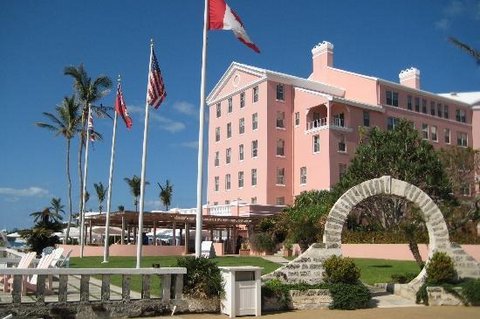
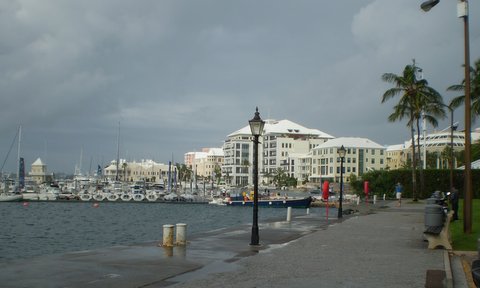
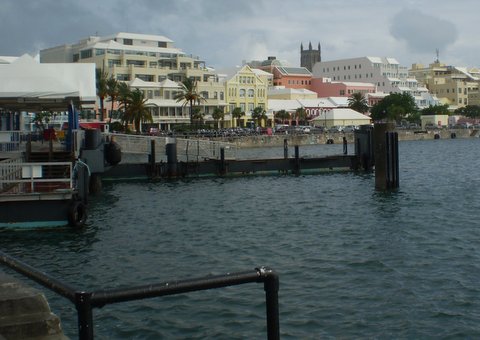
On Pitts Bay Road, to our left, overlooking the Great Sound, stood the magnificent Fairmount Hamilton Princess Hotel (or simply "The Princess"), obviously a place for the very rich and well-heeled business people. During our Bermuda stay, we took the time to pretend to be part of the crowd and entered the hotel's elegant lobby and reception area. We just wanted to have a look because our friend from Australia (see above) had told us that "The Princess" became famous during World II as an intelligence centre where mail and radio communications were analyzed by some 1200 censors belonging to the very secret British Security Coordination (BSC). These people worked/stayed at "The Princess" examining letters for secret communications before re-sealing them to leave no indication that they had been read. I had read much about the BSC and its anti-Nazi operations and it was, for me, a real treat to visit this famous location.
The brainchild behind this covert operation was a Canadian with the name of Sir William Stephenson. Of him, Wikipedia says: " Sir William Samuel Stephenson was a Canadian soldier, airman, businessman, inventor, spymaster and the senior representative of British intelligence for the entire western hemisphere during World War II." It was this millionaire businessman from Winnipeg, Manitoba, who collaborated with British Prime Minister Winston Churchill to covertly establish BSC in New York City, over a year before the U.S. entry into the war!
This is not the place to go further into the Churchill/Stephenson/Roosevelt relationship except to reveal that with BSC -working closely with the FBI- the censors were responsible for the discovery and arrest of a number of Axis spies operating in the U.S.
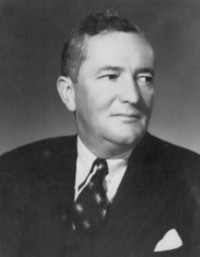
Stephenson became known as "The Quiet Canadian," which is the title of a most interesting book about him, authored by H. Montgomery Hyde. Stephenson's code name during WWII was "Intrepid." A much-read, but controversial, book is "A Man Called Intrepid" by William Stevenson (no kin). Wikipedia mentions that the most accurate account of Stephenson's life is Bill MacDonald's "The True Intrepid."
One of Stephenson's contribution to the war effort was the setting up of BSC's secret Camp X, close to Whitby, Ontario. Some 2000 British, Canadian and American covert operators were trained here from 1941 to 1945. The subject has fascinated me and I've been hunting for books about this famous training school for clandestine operations for years. I'm amazed that, even today, there's a blanket of secrecy regarding the operations inspired/run by "Intrepid" and even the very existence of Camp X!
Sir William Stephenson died on January 31, 1989, aged 92, and was quietly buried in Paget Parish, Bermuda.
A crucial site during World War II
During 1940-1945, Bermuda's importance as a military base increased because of its strategic location on the major trans-Atlantic shipping route.
In 1941, the United States signed a lend-lease agreement with the United Kingdom giving the British surplus U.S. Navy destroyers in exchange for 99-year lease rights to establish naval and air bases in certain British territories. The advantage for Britain of granting these base rights was that the neutral U.S. effectively took responsibility for the security of these territories, freeing British forces to be deployed to the more critical areas of the battle with the Germans.
Following the signing of the 99-year lease a massive land reclamation project by the U.S. Army created a military airfield and naval bases on Bermuda. Anti-aircraft artillery were installed, and submarine patrols used the island as a base from which to scour the Western Atlantic and, hopefully destroy the dangerous German U-boats.
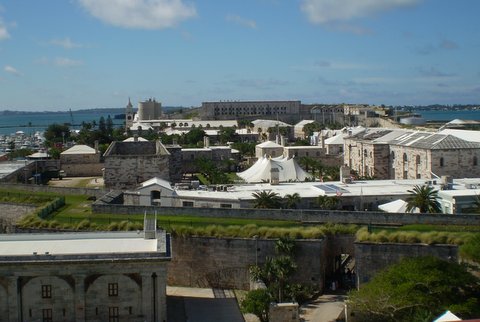
The Royal Navy Dockyard, on Bermuda's Ireland Island, played a role similar to that it had during WWI, overseeing the formation of trans-Atlantic convoys composed of hundred of ships.
Wikipedia states: "Most convoys from Bermuda (coded BHX), once assembled, joined at sea with convoys originating at Halifax, Nova Scotia (coded HX), before crossing the Atlantic, it having been shown mathematically that – the area of a circle increasing disproportionately to its circumference as its radius increased – it required relatively fewer warships to protect one large convoy than two smaller ones."
Although Bermuda was a naval base, her warships were normally spread out all over the Atlantic, thus unable to protect the base or the island, explains the Wikipedia website. Early in the war German battleships, operating as commerce raiders (see previous story entitled "Cornelis Jacob de Jong" - in Hinne de Jong – A Chronicle), created some concern of Bermuda's vulnerability to naval bombardment (especially when Convoy HX 84 – which included ships from Bermuda – was attacked by the German cruiser Admiral Scheer in November 1940), but the island was never attacked, and the threat of German surface vessels and their aircraft quickly faded.
Discovering Bermuda's old-time soul: Town of St. George
We decided to set a day aside to enjoy a fast ferry ride from Hamilton to the Royal Navy Dockyard, the most western point of the archipelago, and then take the catamaran ferry to St. George, the eastern point, and take a bus home after all was said and done.
Under blue skies we crossed the Great Sound staying clear of the many islands which dot this body of water. We headed for the two giant cruise ships at anchor by the dockyard. This was not the time to join the hundreds of tourists there. We boarded a really fast catamaran, which nearly flew us across the open ocean to the Town of St. George. The ferry went so fast that the wind nearly took our breath away. It was exhilarating and I was on cloud nine!
In order to reach St. George's harbour, the ferry had to round the point near the Achilles Bay, then slowly approach the so-called Town Cut – a rather narrow space between some islands – and enter the inland waters there.
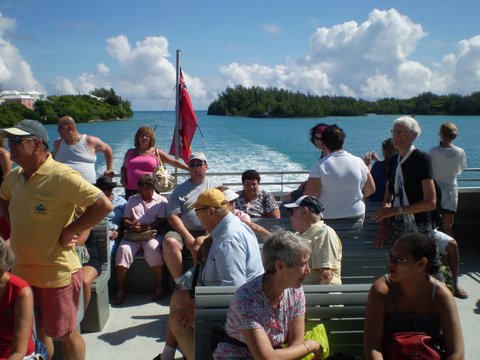
The 400-year old town of St. George, seat of Bermuda's government for two centuries, is a UNESCO World Heritage site. It was the landing point of the first settlers and the oldest permanent English town in the New World. As we wandered through St. George's downtown area and its backstreets, we were amazed at the beautiful panorama of coloured pastel walls all around us. Rosemary Jones wrote in her Handbook: "Visitors get a sense of traditional island life away from Hamilton's bustling side walks and corporate milieu."
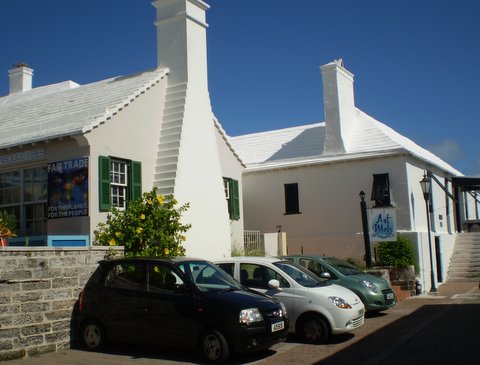
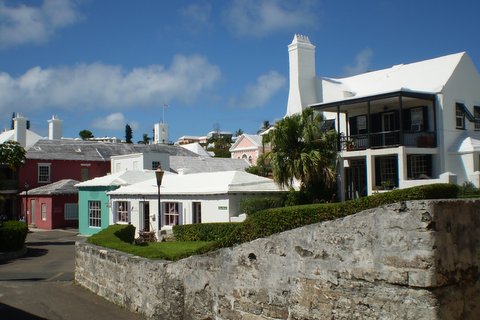
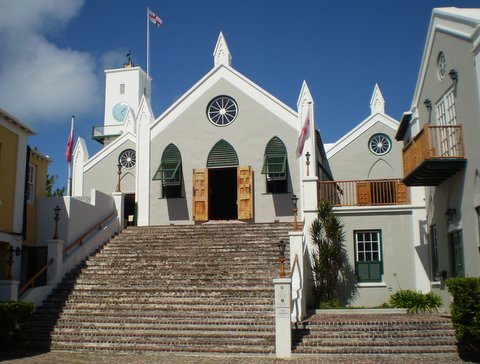
One of Bermuda's most famous buildings, St. George's St. Peter's Church, sits on the place where the first meeting of the fledgling Assembly was held on August 1, 1620. The original structure did not survive but the present St. Peter's Church, built on the same site, qualifies as the oldest Protestant church in the New World.
In the adjacent graveyard notable townsfolk are buried alongside modern VIPSs, writes Jones. "An example of the latter is Sir Richard Sharples, a Bermudian governor, who was assassinated in 1973....Under the shade of coconut palms, a second, separate graveyard holds the bodies of town slaves and free blacks. Even after the Slavery Abolition Act took effect on August 1, 1834, Bermuda's black and white societies remained divided until official segregation was outlawed in the 1960s."
Sabbath Day in Hamilton, Bermuda
There are many churches in Hamilton. The most striking is the Anglican Holy Trinity Cathedral on Church Street. Its architectural style is very reminiscent of the great Anglican Cathedral we had visited so often in St. John's, Newfoundland. (2012)
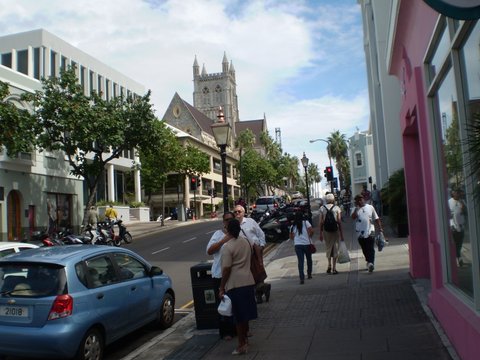
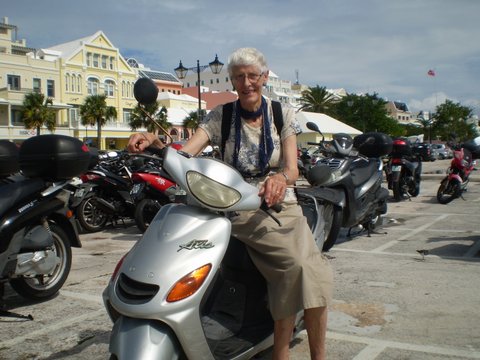
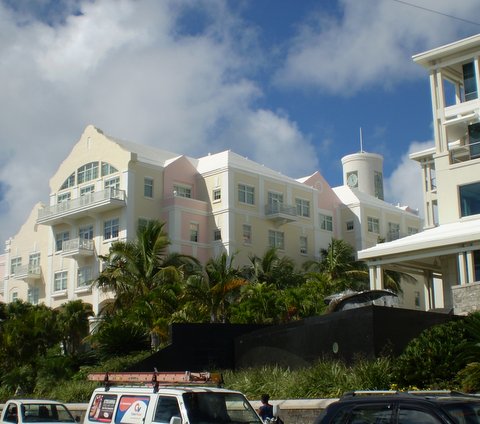
We decided, however, to attend the morning service at St. Andrew's Presbyterian Church, a bit down the street from the Cathedral. We were warmly welcomed by Pastor John Fraser. His eyes lit up when we told him we were from Canada and that we were seasoned immigrants from the Netherlands. What a surprise to learn that he had been pastor of a church in Barrie, Ontario, and that his wife was an immigrant from Holland, like us!
We were pleased that so many people of different backgrounds were represented in the audience. Pastor Fraser introduced the guests in the audience, making special mention of the two of us from St. Catharines, Ontario. Pastor Fraser preached on the theme, "Life After Death," basing his sermon on Job 14: 1:14 and I Cor. 15: 35-44.
We need not be afraid. "Where, O death is your victory? Where, O death, is your sting" (I Cor. 15: 55). We left this small congregation with joy in our hearts and, fortified, we went on our way. God is good, indeed.
Scenic trip to the Dockyard
We made the long trip around the "fish hook" by bus, which meant leaving Pembroke Parish and driving the southern scenic route through Paget, Warwick, Southampton and Sandys Parishes. Destination: Royal Naval Dockyard, on the tip of Ireland Island.
Bermudian bus drivers seem to have no fear. The roads on Bermuda are narrow, just wide enough for two cars. At least so it seems. Having left Hamilton behind us, our right-seated chauffeur, driving on the left lane, was speaking casually with another local seated behind her on the left front seat. She drove mostly with one hand, looking occasionally ahead of her. She never reduced speed while whipping around the many twists and turns in the road ahead of her. Things became even more critical when we crossed the narrow Somerset Bridge and approached the many causeways connecting the many little islands to the Royal Naval Dockyard. It was rather comforting to know that we would have an easy and fast ferry ride back later in the day to Hamilton Harbour.
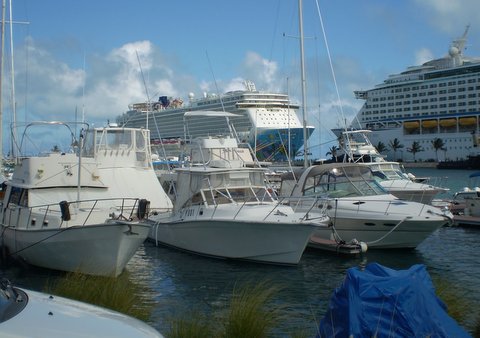
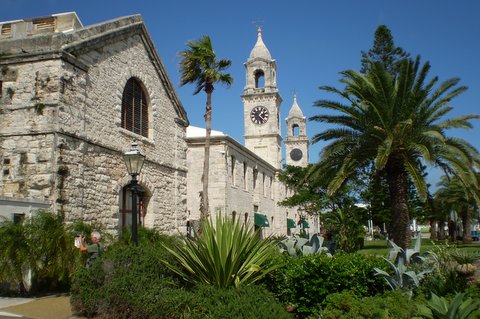
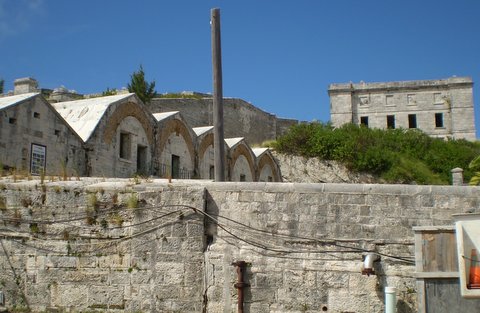
The Dockyard is the main tourist attraction on Bermuda. Like St. George, the Dockyard is crucial to understanding what shaped the political and social history of Bermuda. It was the principal base of the Royal Navy on the Western Atlantic between American Independence and the Cold War. Prior to 1783, Bermuda's Great Sound was a welcome haven for European vessels leaving the New World for home, as well as for French and Bermudian privateers looking for riches on Spanish galleons, and the like.
The construction of the Dockyard – including massive land reclamation – began in the early 1800s. Initially, this work was carried out by black slaves, but after Emancipation in 1834, Britain shipped over thousands of convict labourers from England and Ireland.
(Note: At first, I thought that Boer prisoners from South Africa were also incarcerated on Bermuda's Ireland Island, the location of the Dockyard. This turned out to be untrue. During the Anglo-Boer War (1899-1902), Bermuda received a total of 5000 Boer prisoners of war on five of its islands. These so-called "Bitterenders" (Afrikaans: Bittereinders) – men who refused to pledge allegiance to the British Crown – were interned on Darrell Island. Smaller numbers were sent to Morgan Island, Tucker Island and Burt Island – all located in the Little Sound.)
In the War of 1812 with the U.S., Britain launched the attack on Washington from the Bermuda Dockyard. Writes Rosemary Jones in her Handbook: "Over the next 150 years, Dockyard's Bay anchorage and sheltered docks catered to British greatest warships, which evolved from tall-masted men-of-war and ironclads armed with cannons to steam-driven dreadnoughts and diesel-turbine frigates bearing World War II torpedoes."
Over the years many Bermudians were trained in the skilled trades of masonry, engineering and electrics, all due to a British apprenticeship scheme at the Dockyard. The Royal Navy pulled up stakes in 1951, closing its operations at the Dockyard. For nearly 30 years the base fell into a state of disrepair, with storms and lack of maintenance causing danger to many buildings.
It was not until the 1970s and 1980s that a major renovation campaign transformed the Victorian military buildings into retail centres, restaurants and artists' studios. Speaking with the owners of our B&B, we learned that many Bermudians – using the skills they had gained over the years – communally participated in that massive restoration project.
Today, the Dockyard is a magnet for tourists with thousands streaming off the huge cruise ships which make regular stops there. One could spend a week there and not see everything. The 24-acre area is loaded with shops, eating places, marinas and working boat yards. The now abandoned Casemate Prison- a grim two-storey structure- looms large on the site. The air-conditioned Clock Tower Building is home to a plethora of shops and the beautifully-renovated National Museum of Bermuda and its restored Commissioner's House are must-see places. The view from the latter's balcony of the wide expanse of the Atlantic Ocean is stunning!
Of fabulous beaches, tortoises and sights to see
One day we spent the better part of a day in the South Shore Park located in the Warwick and Southampton Parishes. When we got off at the Warwick bus stop we already saw glimpses of the magnificent pink beaches along the Atlantic. Our goal was to go for a swim at the famous Horseshoe Bay beach. But that meant trekking through the bush and climbing up and down all manner of volcanic rock formations. Seldom have we enjoyed ourselves so much! We walked from Warwick Long Bay beach, to Johnson Cove, Stonehole Bay, Caplin Bay until we joined the crowd enjoying a swim in the ocean at Horseshoe Bay. Bus load after bus load of cruise ship tourists arrived because Horseshoe is the prime spot to be if you want to go for a swim in Bermuda.

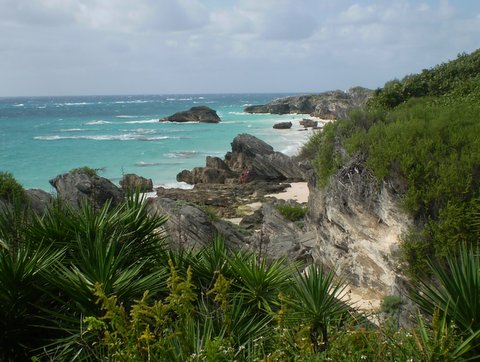
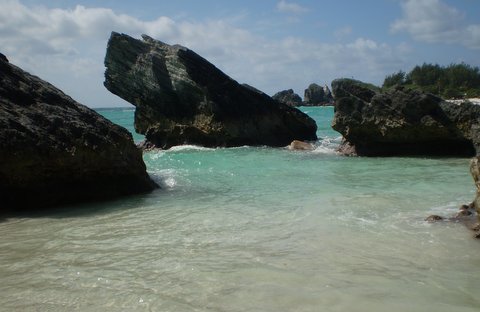
Anyone who ever walked on Church Street in Hamilton will remember seeing the unique design of the City Hall and Arts Centre. Conceived by famed Bermudian architect Wil Onions, it is built like an oversized white cottage with a slate roof and a tower, the latter inspired by Stockholm's city hall. We interacted with some wonderful people at public meetings inside that wonderful place.
After making a visit to the Bermuda Underwater Exploration Institute and learning much about oceanic life and explorations, we took the bus to Flatts Village to see for ourselves the much talked about Bermuda Aquarium, Museum and Zoo. It is a hub for important research and conservation programs and has been accredited by the Association of Zoos and Aquariums (AZA).
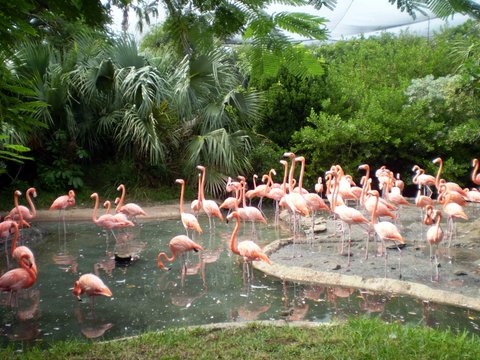
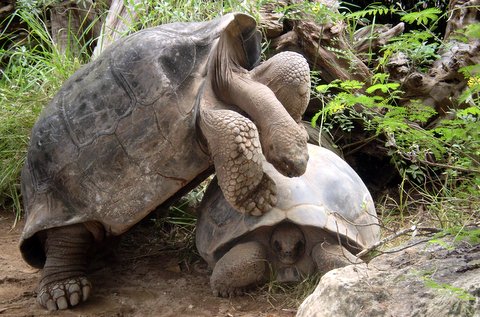
What we did not expect to see was a pair of giant Galapagos Tortoises! We had no clue as to how old they were. They were absolutely huge! We learned that Galapagos Tortoises might reach a weight of over 100 kg. with a life span (in the wild) of over 100 years. These slow-moving creatures certainly looked like they were around on this planet well before World War I (1914-1918).
Our last day on Bermuda again presented us with flawless weather. Another friendly taxi driver took us to the airport. As we drove along the ocean we saw, in the distance, the two cruise ships at anchor by the Dockyard. We sailed though Customs, but we had to go through several fire alarms before we were allowed to board. It all turned out to be a false alarm. We had an uneventful flight back to Toronto Pearson.
Approaching Lake Ontario, the stewardess announced that we were privileged to be flown by a captain who would face retirement after he landed the plane. This was his last flight as an Air Canada captain after many decades of service. She said that a surprise would await us once the jet had landed, because, as is customary at Toronto Pearson, a retiring captain is welcomed by a shower of water spouting forth from a number of fire trucks. Let me tell you, we got doused! It was quite a sight! The much-applauded captain stood by the exit and we shook hands with him and his crew before stepping onto Canadian soil. Back to Niagara, Ontario.
[an error occurred while processing this directive]